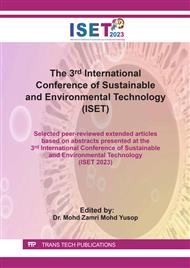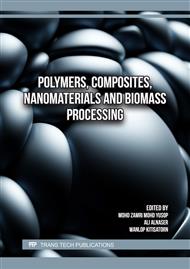[1]
N. Akpan Sunday, Oil Palm Empty Fruit Bunches (OPEFB) – Alternative Fibre Source for Papermaking, in: K. Hesam (Ed.), Elaeis guineensis, IntechOpen, Rijeka, 2022, p. Ch. 10.
DOI: 10.5772/intechopen.98256
Google Scholar
[2]
F.M. Hossain, Palm oil EFB: Green Energy Source in Malaysia, Applied Mechanics and Materials 619 (2014) 376-380.
DOI: 10.4028/www.scientific.net/amm.619.376
Google Scholar
[3]
M.O.P. Board, Overview of The Malaysian Oil Palm Industry 2020, (2020).
Google Scholar
[4]
F.N.M. Padzil, S.H. Lee, Z.M.A.a. Ainun, C.H. Lee, L.C. Abdullah, Potential of Oil Palm Empty Fruit Bunch Resources in Nanocellulose Hydrogel Production for Versatile Applications: A Review, Materials 13(5) (2020) 1245.
DOI: 10.3390/ma13051245
Google Scholar
[5]
E. Pramono, M.A. Zakaria, K.F. Fridiasari, S.T.C.L. Ndruru, M. Bagaskara, R.E. Mustofa, G.P.W. Sejati, C. Purnawan, O.A. Saputra, Cellulose derived from oil palm empty fruit bunches as filler on polyvinylidene fluoride based membrane for water containing humic acid treatment, Groundwater for Sustainable Development 17 (2022) 100744.
DOI: 10.1016/j.gsd.2022.100744
Google Scholar
[6]
E. Onoja, S. Chandren, F.I. Abdul Razak, N.A. Mahat, R.A. Wahab, Oil Palm (Elaeis guineensis) Biomass in Malaysia: The Present and Future Prospects, Waste and Biomass Valorization 10(8) (2019) 2099-2117.
DOI: 10.1007/s12649-018-0258-1
Google Scholar
[7]
M. Zubair, M. Arshad, A. Ullah, 4 - Nanocellulose: A sustainable and renewable material for water and wastewater treatment, in: S. Kalia (Ed.), Natural Polymers-Based Green Adsorbents for Water Treatment, Elsevier (2021) pp.93-109.
DOI: 10.1016/b978-0-12-820541-9.00009-0
Google Scholar
[8]
A.M. Khalid, M.S. Hossain, N. Ismail, N.A. Khalil, V. Balakrishnan, M. Zulkifli, A.N.A. Yahaya, Isolation and Characterization of Magnetic Oil Palm Empty Fruits Bunch Cellulose Nanofiber Composite as a Bio-Sorbent for Cu(II) and Cr(VI) Removal, Polymers (Basel) 13(1) (2020).
DOI: 10.3390/polym13010112
Google Scholar
[9]
D. Trache, A.F. Tarchoun, M. Derradji, T.S. Hamidon, N. Masruchin, N. Brosse, M.H. Hussin, Nanocellulose: From Fundamentals to Advanced Applications, Frontiers in Chemistry 8 (2020).
DOI: 10.3389/fchem.2020.00392
Google Scholar
[10]
P. Phanthong, P. Reubroycharoen, X. Hao, G. Xu, A. Abudula, G. Guan, Nanocellulose: Extraction and application, Carbon Resources Conversion 1 (2018).
DOI: 10.1016/j.crcon.2018.05.004
Google Scholar
[11]
L.Y. Ng, T.J. Wong, C.Y. Ng, C.K.M. Amelia, A review on cellulose nanocrystals production and characterization methods from Elaeis guineensis empty fruit bunches, Arabian Journal of Chemistry 14(9) (2021) 103339.
DOI: 10.1016/j.arabjc.2021.103339
Google Scholar
[12]
H.V. Lee, S.B.A. Hamid, S.K. Zain, Conversion of Lignocellulosic Biomass to Nanocellulose: Structure and Chemical Process, The Scientific World Journal 2014 (2014) 631013.
DOI: 10.1155/2014/631013
Google Scholar
[13]
A.W. Noorshamsiana, Nor Faizah, J., Kamarudin, H., Nur Eliyanti, A. O., Fatiha, I., & Astimar, A. A, Extraction and characterisation of cellulose from the residue of oil palm empty fruit bunch-xylan extraction, Journal of Oil Palm Research 32(4) (2020) 610-620.
DOI: 10.21894/jopr.2020.0052
Google Scholar
[14]
M. T. Honkeldieva, H. Li, K. X. Bukhorov, H. A. Ahmedov and M. V. Yulbarsova, IOP Conference Series: Earth and Environmental Science 868 (1), 012042 (2021).
DOI: 10.1088/1755-1315/868/1/012042
Google Scholar
[15]
M. Rayung, N. Ibrahim, N. Zainuddin, W. Saad, N. Razak, B.W. Chieng, The Effect of Fiber Bleaching Treatment on the Properties of Poly(lactic acid)/Oil Palm Empty Fruit Bunch Fiber Composites, International journal of molecular sciences 15 (2014) 14728-14742.
DOI: 10.3390/ijms150814728
Google Scholar



